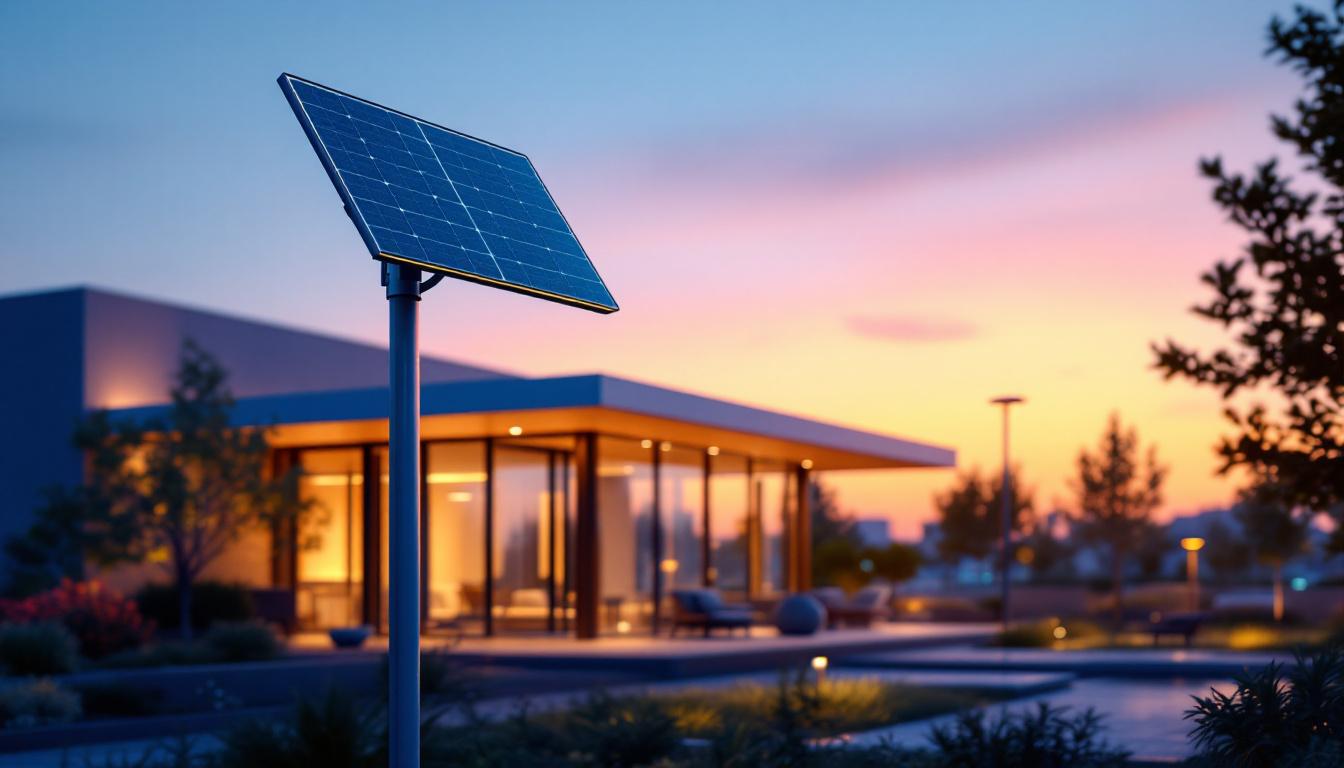
Solar building lights have become a transformative solution in the lighting industry, especially for contractors seeking sustainable, cost-effective, and efficient options. These lighting systems harness solar energy to illuminate indoor and outdoor spaces, reducing reliance on traditional electrical grids. With rising energy costs and increasing environmental regulations, understanding the intricacies of solar lighting is essential for lighting contractors aiming to offer cutting-edge solutions to their clients.
In this comprehensive guide, lighting professionals will explore the technology behind solar building lights, their benefits, installation considerations, and the latest trends shaping the market. This knowledge will empower contractors to make informed decisions and deliver high-quality, eco-friendly lighting projects.
One of the most significant advantages of solar building lights is their ability to operate independently of the electrical grid, making them particularly valuable in remote areas or during power outages. These systems typically consist of solar panels, batteries, and LED fixtures, which work in tandem to provide reliable illumination. The solar panels capture sunlight during the day, converting it into energy that is stored in batteries for use at night. This not only ensures a consistent light source but also significantly reduces electricity costs over time. Additionally, the installation of solar lights can often be completed without the need for extensive wiring, making them a convenient option for quick deployment in various settings.
Moreover, advancements in solar technology have led to the development of more efficient photovoltaic cells and energy storage solutions, further enhancing the performance of solar building lights. Modern systems can now include smart technology features, such as motion sensors and timers, which optimize energy usage and extend battery life. As the demand for sustainable solutions continues to grow, contractors who stay informed about these innovations will be better positioned to meet their clients’ needs while contributing to a greener future. With an increasing emphasis on sustainability in construction, integrating solar building lights into projects not only elevates the aesthetic appeal but also aligns with eco-conscious values that many clients prioritize today.
At the core of every solar building light system lies a few critical components: solar panels, rechargeable batteries, LED light fixtures, and a controller unit. Solar panels capture sunlight and convert it into electrical energy through photovoltaic cells. This energy is then stored in batteries to power the LED lights during nighttime or low-light conditions. The efficiency of solar panels can vary based on their material composition, with monocrystalline panels generally offering higher efficiency rates compared to polycrystalline options, making them a popular choice for many applications.
The controller regulates the charging and discharging of the battery, ensuring optimal performance and preventing overcharging or deep discharge, which can reduce battery life. LED technology is favored in solar lighting due to its high energy efficiency, long lifespan, and low maintenance requirements. Moreover, advancements in LED technology have led to the development of smart lighting options, which can adjust brightness based on ambient light levels or be controlled remotely via mobile applications, adding a layer of convenience and energy savings.
Solar lighting solutions vary based on application and design. Common types include:
Each type serves different functional and design needs, allowing contractors to tailor solutions based on client requirements. Additionally, the growing trend of sustainability has led to an increase in the use of solar building lights in urban planning and development projects, as they contribute to reducing carbon footprints and energy costs. As technology continues to evolve, we can expect to see even more innovative designs and functionalities, such as solar lights that integrate with smart city infrastructure, providing enhanced connectivity and efficiency.
One of the most compelling advantages of solar building lights is their ability to significantly reduce energy consumption. By utilizing free solar energy, these systems minimize electricity bills for building owners. Over time, the initial investment in solar lighting pays off through lower operating costs and reduced maintenance expenses.
For contractors, promoting energy-efficient lighting solutions can enhance project value and appeal to environmentally conscious clients. Additionally, solar lighting systems often qualify for government incentives or rebates, further improving return on investment.
Solar building lights contribute to lowering carbon footprints by decreasing dependence on fossil fuel-based electricity. This aligns with global efforts to combat climate change and supports corporate social responsibility goals for businesses and institutions.
Lighting contractors who specialize in sustainable solutions position themselves as industry leaders, attracting clients who prioritize green building certifications such as LEED or WELL. Offering solar lighting can be a key differentiator in competitive markets.
Unlike conventional lighting systems, solar building lights often require minimal wiring and trenching. This reduces installation time, labor costs, and site disruption. For retrofit projects or buildings with limited electrical infrastructure, solar lighting provides a practical alternative.
The modular nature of many solar lighting products allows for scalable installations, from a few fixtures to large arrays. This flexibility enables contractors to customize designs that meet specific lighting levels and coverage areas.
Proper site evaluation is critical to the success of any solar lighting project. Contractors must assess solar access, ensuring that panels receive adequate sunlight throughout the day. Factors such as shading from trees, adjacent buildings, and roof orientation can significantly impact system performance.
Using solar pathfinder tools or software can help identify optimal panel placement and predict energy generation. This step prevents underperformance and client dissatisfaction.
The battery is a vital component that determines how long solar lights can operate after sunset. Selecting batteries with sufficient capacity to store energy for anticipated usage hours and weather variability is essential. Lithium-ion batteries are increasingly preferred due to their higher energy density, longer lifespan, and lighter weight compared to traditional lead-acid batteries.
Contractors should also consider maintenance requirements and replacement schedules to provide clients with realistic expectations and service plans.
Effective lighting design balances brightness, coverage, and energy consumption. Utilizing photometric analysis helps in selecting appropriate fixtures and positioning to achieve uniform illumination without glare or dark spots. Adhering to local lighting codes and standards ensures safety and regulatory compliance.
For commercial and public buildings, integrating solar lighting with existing control systems or smart technologies can enhance functionality and user experience.
Advancements in IoT and sensor technologies have led to the development of smart solar lighting solutions. These systems can adjust brightness based on occupancy or ambient light, communicate status remotely, and optimize energy usage dynamically.
For contractors, offering smart solar lighting can add value by providing clients with enhanced control, security features, and data-driven maintenance alerts.
Hybrid systems combine solar power with grid electricity or other renewable sources to ensure consistent lighting even during extended periods of low sunlight. This approach addresses limitations related to battery capacity and weather dependency.
Hybrid solutions are particularly useful in regions with variable climates or critical applications where uninterrupted lighting is mandatory.
Integrating solar lighting with building automation systems enables centralized control and monitoring. This integration supports energy management strategies, reduces operational costs, and improves occupant comfort.
Lighting contractors skilled in automation technologies can leverage this trend to provide comprehensive smart building solutions.
One of the primary challenges in solar lighting is managing performance during cloudy or rainy periods. Insufficient solar charging can lead to reduced light output or outages. Selecting high-quality batteries with adequate storage capacity and incorporating energy-efficient LEDs mitigates this risk.
Contractors should educate clients about these limitations and design systems with appropriate redundancies or hybrid options.
Despite long-term savings, the upfront cost of solar lighting systems can be a barrier for some clients. Lighting contractors play a crucial role in demonstrating total cost of ownership, including energy savings, maintenance reduction, and potential incentives.
Providing case studies, ROI analyses, and financing options can help overcome budget concerns and build client confidence.
Solar lighting systems require periodic cleaning of panels, battery checks, and fixture inspections to maintain optimal performance. Establishing maintenance schedules and offering service contracts can ensure system longevity and customer satisfaction.
Contractors should also stay informed about technological advancements to recommend timely upgrades or replacements.
Solar building lights represent a forward-thinking approach to illumination that aligns with economic, environmental, and technological priorities. For lighting contractors, mastering the design, installation, and maintenance of solar lighting systems opens new avenues for business growth and client engagement.
As innovations continue to enhance efficiency, intelligence, and integration capabilities, solar building lights will increasingly become a standard component of modern lighting projects. Embracing this technology not only supports sustainable development but also positions contractors at the forefront of the evolving lighting industry.
Ready to lead the charge in sustainable lighting solutions? LumenWholesale is here to support your journey with our premium, spec-grade solar building lights. We offer the best value in wholesale lighting, ensuring you can equip your projects with top-quality products without the burden of inflated costs. Benefit from our extensive selection that meets rigorous industry standards and enjoy the convenience of free shipping on bulk orders. Elevate your lighting projects with the efficiency, affordability, and quality that LumenWholesale provides. Start browsing our collection today and take the first step towards a brighter, greener future. Wholesale Lighting at the Best Value.

Discover effective strategies for training your team in outdoor lighting techniques.

Discover how to enhance your workspace with LED high bay shop lights by optimizing for maximum efficiency.

Discover how water-resistant wire connectors are transforming the lighting industry with real-world success stories from contractors.

Discover how LED light bulbs revolutionize safety in lighting installations.